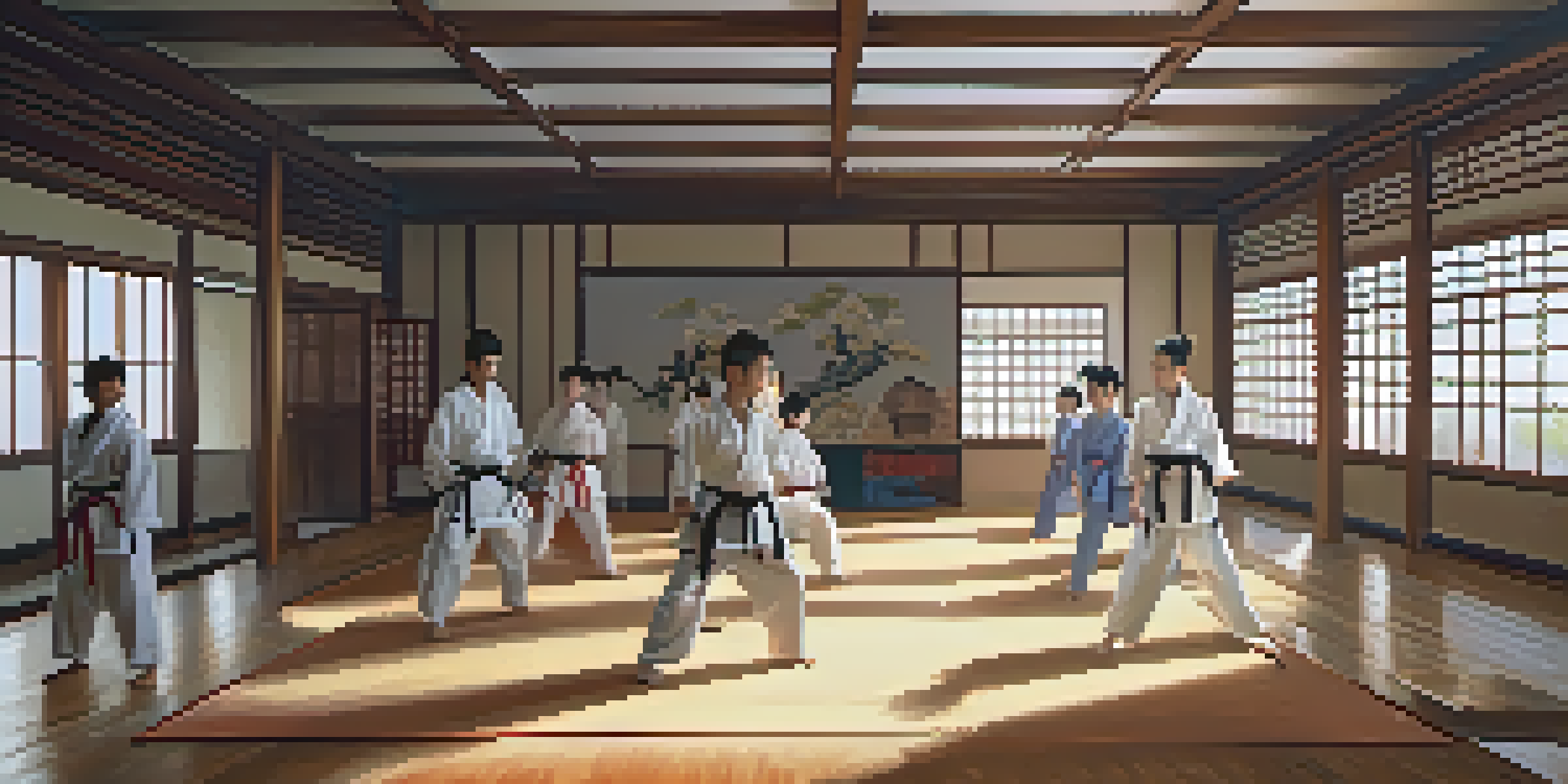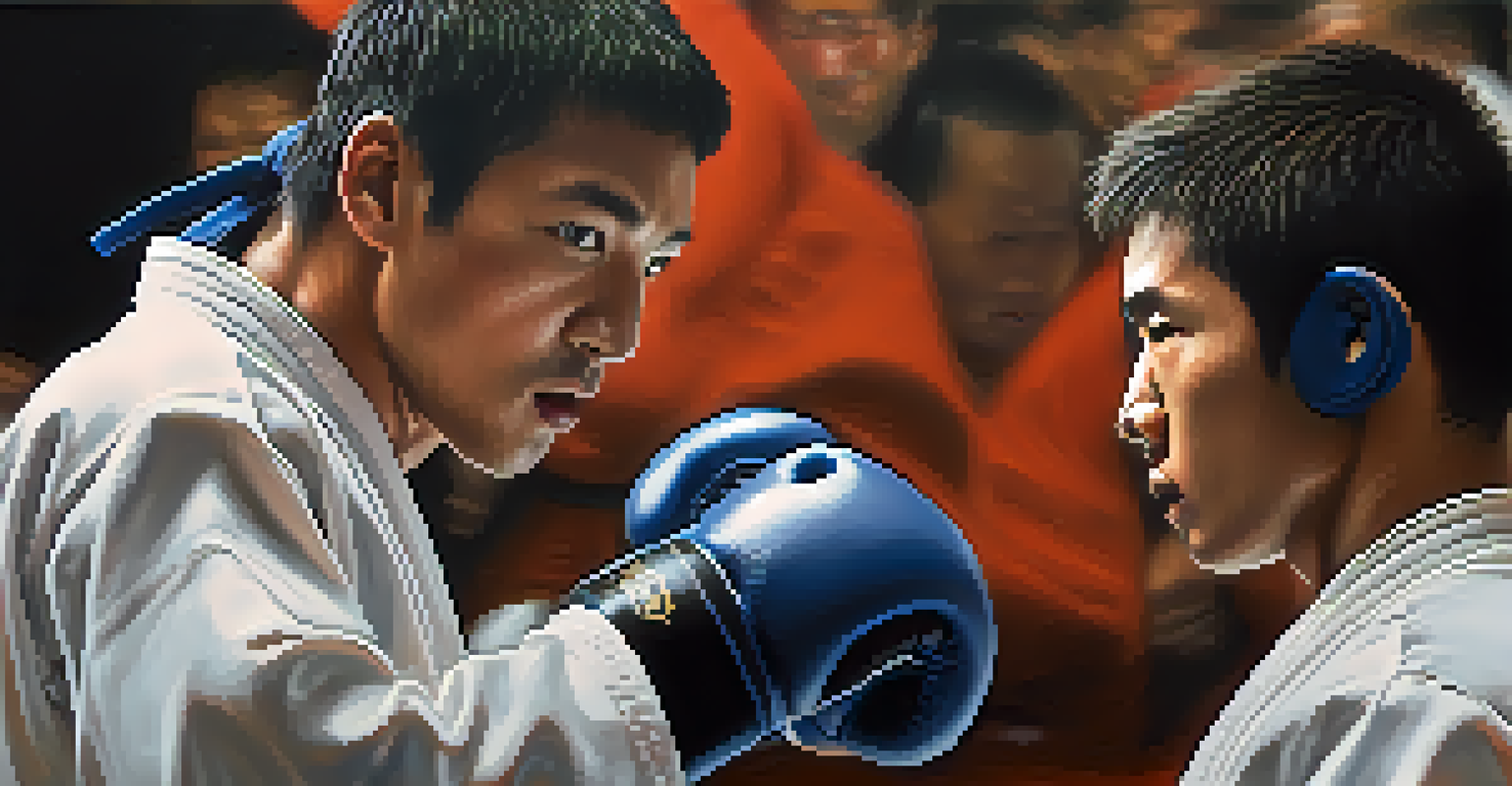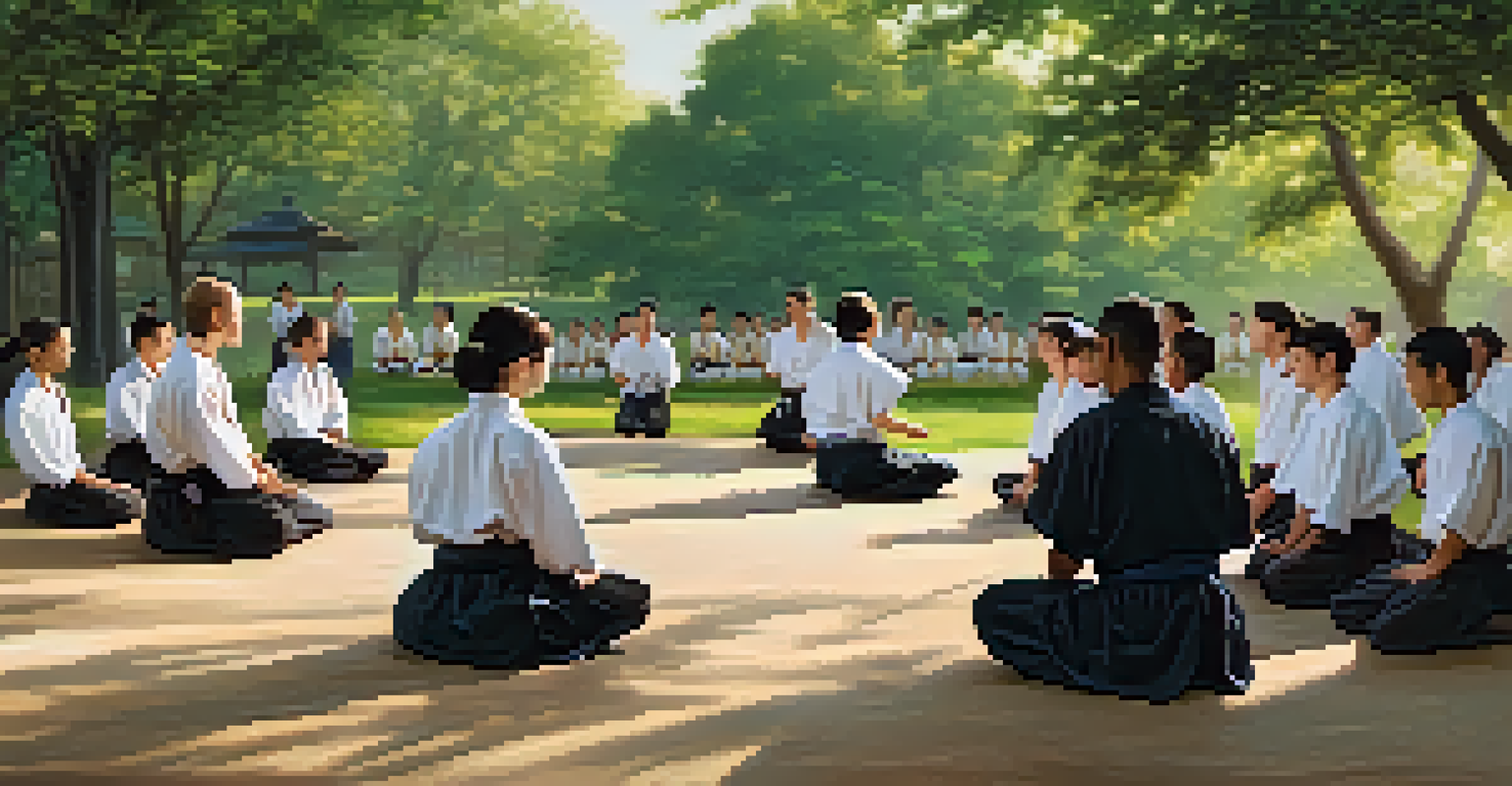Verbal Techniques in Martial Arts for Peaceful Conflict Resolution

Understanding the Role of Communication in Martial Arts
Martial arts is often associated with physical combat, but communication plays a vital role in its practice. Instructors emphasize the importance of verbal techniques alongside physical training, teaching students how to express themselves clearly. This dual focus helps practitioners navigate conflicts with a balanced approach, enhancing both their fighting and interpersonal skills.
The most important thing in communication is hearing what isn't said.
For instance, during sparring sessions, students learn to communicate non-verbally through body language and eye contact. However, verbal communication is equally important when discussing strategies or resolving disputes. By mastering both forms of communication, martial artists can engage in more meaningful interactions, whether on or off the mat.
Ultimately, understanding the role of communication in martial arts fosters a culture of respect and understanding. It encourages practitioners to think critically about their words and actions, creating an environment conducive to peaceful conflict resolution.
Active Listening: A Key Component of Conflict Resolution
Active listening is a fundamental verbal technique that can transform conflicts into constructive conversations. In martial arts, listening attentively to instructors and peers is crucial for growth and development. This skill allows practitioners to fully understand the perspectives of others, paving the way for effective problem-solving.

During training, students are encouraged to listen not just to the words spoken but also to the emotions behind those words. This deeper understanding can help defuse potential confrontations. For example, if a training partner feels frustrated, acknowledging their feelings can shift the dynamic from conflict to collaboration.
Communication Enhances Martial Arts
Effective communication, both verbal and non-verbal, is crucial in martial arts for fostering respect and resolving conflicts.
By practicing active listening, martial artists become more empathetic and aware of their surroundings. This not only enhances their abilities on the mat but also equips them with the tools to resolve conflicts peacefully in everyday life.
Using 'I' Statements to Express Feelings
'I' statements are an effective way to communicate feelings without placing blame. In martial arts, practitioners learn to express their emotions clearly and assertively, which is vital during conflicts. For instance, saying, 'I feel overwhelmed when the pace is too fast' allows individuals to share their experience without accusing others.
Empathy is about finding echoes of another person in yourself.
This technique encourages open dialogue, fostering an environment where everyone feels safe to express themselves. By focusing on personal feelings rather than accusations, conflicts can often be resolved more amicably. This approach not only applies to the dojo but also translates well into personal and professional relationships.
The use of 'I' statements promotes accountability and personal responsibility, essential qualities in both martial arts and conflict resolution. Practicing this technique can significantly improve communication and understanding among practitioners.
The Power of Empathy in Conflict Situations
Empathy is the ability to understand and share the feelings of others, and it's a vital skill in martial arts. Practitioners learn to put themselves in their opponents' shoes, which can help de-escalate tense situations. For example, recognizing that a fellow student may be struggling can lead to supportive dialogue rather than conflict.
Instructors often encourage students to reflect on their own experiences during training. This introspection fosters a deeper connection with others, allowing martial artists to respond to conflicts with compassion. Empathy can transform a potentially aggressive encounter into a constructive conversation, promoting a peaceful resolution.
Empathy Transforms Conflicts
Practicing empathy allows martial artists to understand others' feelings, leading to more compassionate responses in tense situations.
By cultivating empathy, martial artists not only improve their skills but also contribute to a more harmonious community. This practice underscores the idea that understanding others is just as important as mastering physical techniques.
Setting Boundaries with Respect and Clarity
Setting boundaries is essential for maintaining healthy relationships, especially in martial arts. Clear communication about personal limits helps prevent misunderstandings and conflicts. Practitioners learn to express their boundaries respectfully, ensuring that others are aware of their comfort zones.
For instance, if a student feels uneasy about a particular sparring technique, articulating this concern can prevent potential conflicts. By setting boundaries, individuals establish a framework for mutual respect and understanding. This clarity allows everyone involved to participate in training safely and confidently.
Respectful boundary-setting not only enhances training experiences but also fosters a culture of safety and support. In doing so, martial artists develop skills that extend beyond the dojo, empowering them to navigate conflicts in everyday life.
Conflict Resolution Through Collaborative Problem-Solving
Collaborative problem-solving is a technique that encourages individuals to work together to find mutually beneficial solutions. In martial arts, this approach is often practiced during group exercises and discussions. It teaches students the value of teamwork and communication in resolving conflicts.
For example, if two students have a disagreement about a technique, they can work together to find a solution that satisfies both parties. This practice not only resolves the immediate conflict but also strengthens relationships and builds trust. The skills gained through collaborative problem-solving are invaluable for both personal and professional interactions.
Skills for Everyday Life
The verbal techniques learned in martial arts are applicable in everyday interactions, promoting healthier relationships and conflict resolution.
By fostering a spirit of cooperation, martial artists can create a supportive environment that prioritizes conflict resolution. This collaborative mindset helps cultivate a sense of community, making the dojo a safe space for growth and learning.
Mindfulness: Staying Calm in the Heat of Conflict
Mindfulness is the practice of being present and fully engaged in the moment, and it's a powerful tool for conflict resolution. In martial arts, practitioners learn to stay calm and focused during high-pressure situations. This ability to maintain composure can help diffuse tension and prevent escalation.
Techniques such as deep breathing and visualization can aid in cultivating mindfulness. For instance, taking a moment to breathe deeply before responding to a conflict can provide clarity and perspective. This practice helps individuals approach situations with a calm mindset rather than reacting impulsively.

Incorporating mindfulness into conflict resolution not only benefits martial artists on the mat but also in their daily lives. By staying grounded, they can handle disagreements more effectively and maintain healthier relationships.
The Lasting Impact of Verbal Techniques in Everyday Life
The verbal techniques learned in martial arts extend far beyond the dojo, influencing everyday interactions. Practitioners often find themselves using these skills in various situations, from resolving disputes with friends to navigating challenges at work. This adaptability showcases the real-world value of these techniques.
By incorporating communication skills, active listening, and empathy into their daily lives, martial artists can foster healthier relationships. The impact of these techniques can lead to a more peaceful and understanding environment, both at home and in the community. For instance, someone trained in martial arts may approach a disagreement with a coworker in a more constructive manner.
In essence, the verbal techniques learned in martial arts empower individuals to handle conflicts peacefully and effectively. This lasting impact illustrates that martial arts is not just about physical prowess but also about developing strong, respectful communication skills.